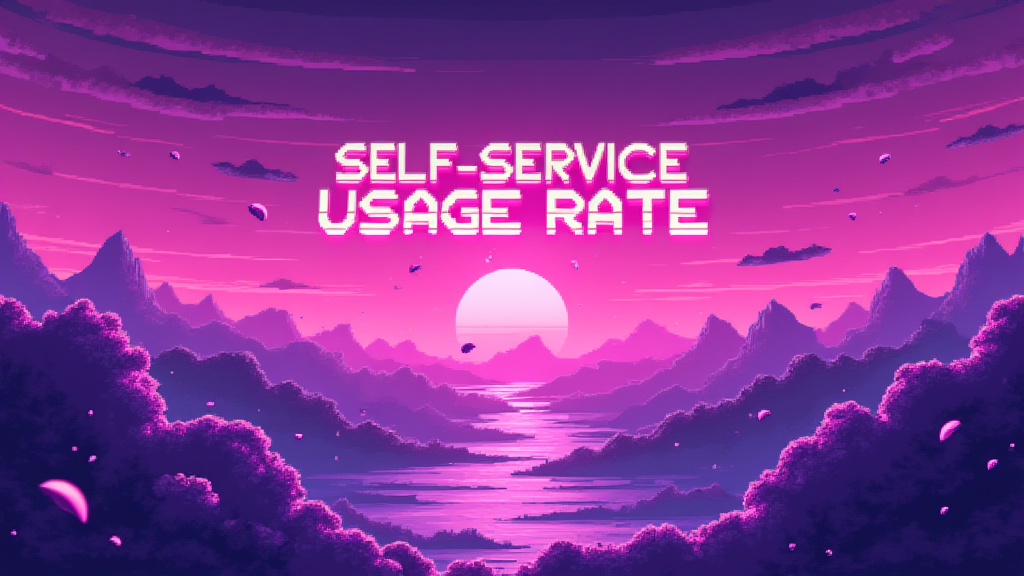Self-Service Usage Rate: Key Metric for Success

Published on: October 01, 2024
In the world of Sales, Marketing, and Revenue Operations, understanding and optimizing the Self-Service Usage Rate is crucial for businesses aiming to streamline their customer support processes and improve overall efficiency. This metric measures the percentage of customers who successfully resolve their issues or complete tasks without requiring direct assistance from company representatives.
Understanding Self-Service Usage Rate 📊
The Self-Service Usage Rate is calculated by dividing the number of successful self-service interactions by the total number of support interactions (both self-service and assisted) over a specific period. This can be expressed as:
Self-Service Usage Rate = (Successful Self-Service Interactions / Total Support Interactions) x 100
A higher Self-Service Usage Rate indicates that more customers are finding the information or solutions they need independently, which can lead to:
- Reduced support costs
- Improved customer satisfaction
- Faster issue resolution times
- Increased scalability of support operations
Importance in Sales and Marketing Operations 🚀
For Sales and Marketing teams, a high Self-Service Usage Rate can have significant benefits:
- Improved Lead Quality: Customers who can find information easily are often more informed and qualified leads.
- Faster Sales Cycles: Self-service resources can help prospects move through the sales funnel more quickly.
- Enhanced Customer Experience: Empowering customers to find answers on their own can increase satisfaction and loyalty.
- Data-Driven Insights: Analyzing self-service interactions can provide valuable insights into customer needs and behavior.
Strategies to Improve Self-Service Usage Rate 🛠️
To increase your Self-Service Usage Rate, consider implementing the following strategies:
- Develop a Comprehensive Knowledge Base: Create and maintain an easily searchable repository of articles, FAQs, and tutorials.
- Implement Chatbots: Use AI-powered chatbots to guide users through common issues and queries.
- Optimize User Interface: Ensure your self-service platforms are intuitive and user-friendly.
- Provide Video Tutorials: Create visual guides for complex processes or product features.
- Gather and Act on Feedback: Continuously improve your self-service offerings based on user feedback and usage data.
Common Challenges and Solutions 🤔
While striving to improve Self-Service Usage Rate, businesses may encounter several challenges:
| Challenge | Solution |
|---|---|
| Low adoption rates | Promote self-service options through various channels and incentivize their use |
| Incomplete or outdated information | Regularly review and update self-service content |
| Complex issues requiring human intervention | Implement escalation paths to connect users with live support when needed |
Measuring Success Beyond the Numbers 📈
While a high Self-Service Usage Rate is generally positive, it's essential to consider other factors when evaluating the success of your self-service initiatives:
- Customer Satisfaction Scores: Ensure that self-service options are actually meeting customer needs.
- Resolution Rates: Track how many issues are fully resolved through self-service channels.
- Time to Resolution: Measure how quickly customers can find solutions compared to assisted support.
- Repeat Contact Rates: Monitor if customers need to reach out multiple times for the same issue.
By focusing on these additional metrics alongside your Self-Service Usage Rate, you can gain a more comprehensive understanding of your self-service effectiveness and its impact on your overall customer experience.
Implementing Self-Service in Your Sales and Marketing Stack 🤓
As you consider improving your Self-Service Usage Rate, ask yourself these questions:
- What are the most common questions or issues our customers face?
- How can we make our self-service options more visible and accessible?
- What tools or technologies can we integrate to enhance our self-service capabilities?
- How can we use data from self-service interactions to improve our sales and marketing strategies?
- What training or resources do our teams need to support and promote self-service options?
By addressing these questions, you'll be well on your way to optimizing your Self-Service Usage Rate and reaping the benefits of improved efficiency and customer satisfaction.

















